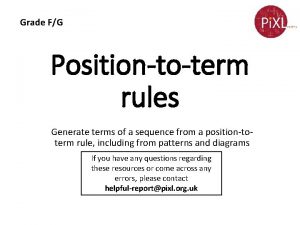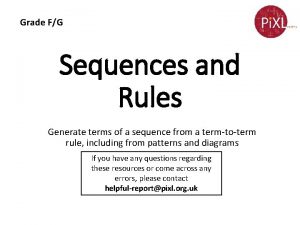Grade FG Positiontoterm rules Generate terms of a










- Slides: 10

Grade F/G Position-to-term rules Generate terms of a sequence from a position-toterm rule, including from patterns and diagrams If you have any questions regarding these resources or come across any errors, please contact helpful-report@pixl. org. uk

Key Vocabulary Sequence Term Position-to-term rule

Position-to-term Rule The position-to-term rule are the operations applied to the position number of a term in a sequence in order to generate that term. Examples: Write down the first five terms of the sequence for each of these position-to-term rules. (a) Position number add 8 Position No 1 2 3 4 5 Add 8 9 10 11 12 13 (b) (3 x position number) subtract 2 Position No 1 2 3 4 5 Multiply 3 3 6 9 12 15 Subtract 2 1 4 7 10 13

Now you try: Write down the first five terms of the sequence for each of these positionto-term rules. a) position number subtract 3 – 2, – 1, 0, 1, 2 b) 5 x position number 5, 10, 15, 20, 25 c) position number ÷ 2 0. 5, 1, 1. 5, 2, 2. 5 d) (4 x position number) add 1 5, 9, 13, 17, 21 e) (position number add 4) x 2 10, 12, 14, 16, 18

Position-to-term Rule The table shows the first five terms of a number sequence and their position in the sequence. (a) Describe the position-to-term rule Position No 1 2 3 4 5 Term 9 18 27 36 45 (b) Write down the 20 th term in the sequence Solution (a) The position-to-term rule is the position number multiplied by 9 or position number x 9 (b) The 20 th term is 20 x 9 =180

Now you try: Write down the position-toterm rule for each of these sequences Position No 1 2 3 4 5 Term 12 13 14 15 16 position number add 11 Position No 1 2 3 4 5 Term 6 12 18 24 30 position number x 6 Position No 1 2 3 4 5 Term 3 5 7 9 11 (2 x position number) add 1 Position No 1 2 3 4 5 Term 9 19 29 39 49 (10 x position number) subtract 1

Position-to-term Rule From Patterns Look at these shapes made from squares Shape 1 Shape 2 Shape 3 Shape 4 (a) Draw the 4 th shape. (b) Complete the table Shape No 1 2 3 4 5 No of squares 5 7 9 11 13 (c) Write down the position-to-term rule No. of squares = 2 x position number + 3

Problem Solving and Reasoning The table shows some terms in a number sequence and their position in the sequence. Position No Term 1 8 2 3 4 5 6 16 24 32 40 48 (a) Complete the table (b) What is the 9 th term in the sequence? The position-to term rule is position number x 8 9 x 8 = 72 (c) Is 100 in the sequence? Explain your answer. The sequence only contains multiples of 8 100 is not in the 8 times table, so is not in the sequence

Problem Solving and Reasoning The position-to-term rule of a sequence is 5 x the position number add 6. Which term of the sequence is equal to 161? Use inverse operations subtract 6 then divide 5 161 – 6 = 155 ÷ 5 = 31 The 31 st term of the sequence is 161

Problem Solving and Reasoning Here are the first 5 terms of an arithmetic sequence 1, 5, 9, 13, 17 Rosie says that 127 is in the sequence. Find the position-to-term rule and use it to show that Rosie is wrong. Position-to-term rule is 4 x position number subtract 3 127 + 3 = 135 130 ÷ 4 = 32. 5 There is no such thing as a 32. 5 th term so 127 is not in the sequence.
 Polynomial degrees and terms
Polynomial degrees and terms Identify like terms
Identify like terms International rules for the interpretation of trade terms
International rules for the interpretation of trade terms International rules for the interpretation of trade terms
International rules for the interpretation of trade terms Generate phone number 080
Generate phone number 080 Masalah ruang keadaan dan pencarian
Masalah ruang keadaan dan pencarian Jmp in excel
Jmp in excel Contoh soal metode generate and test
Contoh soal metode generate and test Verilog parameter
Verilog parameter A large population of aloha users manages to generate
A large population of aloha users manages to generate Axiom of urban economics
Axiom of urban economics



















